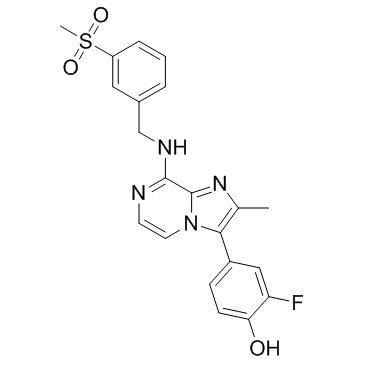BF 738735
Modify Date: 2024-01-11 21:09:54

BF 738735 structure
|
Common Name | BF 738735 | ||
|---|---|---|---|---|
| CAS Number | 1436383-95-7 | Molecular Weight | 426.464 | |
| Density | 1.4±0.1 g/cm3 | Boiling Point | N/A | |
| Molecular Formula | C21H19FN4O3S | Melting Point | N/A | |
| MSDS | N/A | Flash Point | N/A | |
Use of BF 738735BF738735 is a phosphatidylinositol 4-kinase III beta (PI4KIIIβ) inhibitor with an IC50 of 5.7 nM. |
| Name | BF738735 |
|---|---|
| Synonym | More Synonyms |
| Description | BF738735 is a phosphatidylinositol 4-kinase III beta (PI4KIIIβ) inhibitor with an IC50 of 5.7 nM. |
|---|---|
| Related Catalog | |
| Target |
PI4KIIIβ:5.7 nM (IC50) PI4KIIIα:1.7 μM (IC50) |
| In Vitro | BF738735 (Compound 1) strongly inhibits PI4KIIIβ activity in vitro, with an IC50 of 5.7 nM. BF738735 also impairs PI4KIIIα, but only at an ~300-fold-higher concentration (IC50 of 1.7 μM). In addition, the activity of BF738735 is analyzed on a set of 150 cellular kinases, including 13 lipid kinases at a concentration of 10 μM. For all kinases, the inhibition is less than 10%, indicating that BF738735 specifically inhibits PI4KIIIβ in vitro. BF738735 exhibits a broad spectrum of antiviral activity, as it inhibits all tested species of enteroviruses and rhinoviruses, with 50% effective concentrations ranging between 4 and 71 nM. BF738735 potently inhibits all viruses tested, with EC50s ranging between 4 and 71 nM. The cytotoxicity of BF738735, determined in parallel with the EC50 and using the same culture conditions for 3 to 4 days, is low, with CC50 values ranging from 11 to 65 μM, resulting in high selectivity indices. Low concentrations of BF738735 reduce the amount of luciferase to GuaHCl-treated levels, suggesting that the BF738735 blocks viral RNA replication. The EC50 of BF738735 in this assay is 77 nM, which is comparable to the inhibition observed in the multicycle assay for coxsackievirus serotype B3 (CVB3)[1]. |
| In Vivo | BF738735 is well tolerated by specimens with good plasma levels of the antiviral in circulation and a complete inhibition with 25 mg/kg and some inhibition with 5 mg/kg dose is observed[2]. |
| Kinase Assay | The PI4K in vitro activity assay is performed. Briefly, recombinant PI4KIIIβ or PI4KIIIα and their substrate, phosphatidylinositol (PI)-phosphatidylserine (PS), are diluted in buffer containing Triton X-100. The reaction is started by addition of a mixture of ATP and 0.25 μCi of [γ-33P]ATP. After 75 to 90 min of incubation at 30°C, the reaction is terminated by addition of phosphoric acid. The incorporated radioactivity is measured by using a TopCount NXT microplate scintillation counter. Data are converted to the percent inhibition relative to controls[1]. |
| Cell Assay | Buffalo green monkey (BGM) kidney cells, HeLa R19 cells, and HeLa Rh cells are grown at 37°C, 5% CO2 in minimal essential medium (MEM) supplemented with 10% fetal bovine serum, penicillin, and streptomycin. The assays to determine the 50% effective concentration (EC50) and 50% cytotoxic concentration (CC50) of BF738735 are performed. Briefly, cells are infected with 100 CCID50 for 2 h, after which the virus is removed and serial dilutions of BF738735 (0.01, 0.033, 0.1, 0.33, 1, 3.33, 10, 33.33 and 100 μM) are added. For determination of the CC50, serial dilutions of BF738735 are added to the cells. Following 3 to 4 days of incubation, the medium is replaced with CellTiter 96 AQueous One solution reagent. Optical densities at 490 nm are corrected for background absorbance, which is determined from wells that lack cells. The resulting values for untreated cells are set to 100%[1]. |
| Animal Admin | Mice[2] BF738735 is used to study the bioavailability and antiviral effect in vivo. BF738735 is administrated in mice, 1 mg/kg intravenously or 5 mg/kg orally to treat coxsackievirus serotype B4 (CVB4) induced pancreatitis. |
| References |
[2]. V Saarnio. Antiviral Molecules of Enteroviruses. 13.1.2017. |
| Density | 1.4±0.1 g/cm3 |
|---|---|
| Molecular Formula | C21H19FN4O3S |
| Molecular Weight | 426.464 |
| Exact Mass | 426.116180 |
| LogP | 2.68 |
| Index of Refraction | 1.672 |
| 2-Fluoro-4-(2-methyl-8-{[3-(methylsulfonyl)benzyl]amino}imidazo[1,2-a]pyrazin-3-yl)phenol |
| Phenol, 2-fluoro-4-[2-methyl-8-[[[3-(methylsulfonyl)phenyl]methyl]amino]imidazo[1,2-a]pyrazin-3-yl]- |